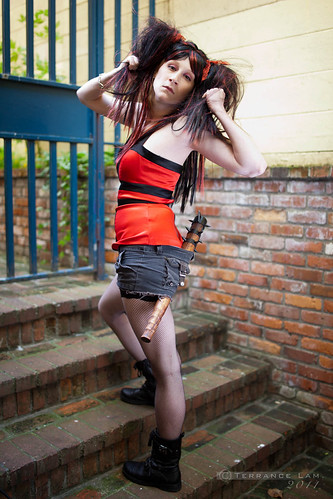Rokinon/Samyang 35mm f/1.4 AS UMC
 |
| Fellow photographer tries it on the D300s |
I had the opportunity to test out an AE version which almost is enough reason to pick up a Nikon just so you can use this superb piece of glass with. I envy some of the features you get with the AE version that you can't get on the Canon such as the auto aperture which is handy especially not only in metering, but also when you're trying to focus on the subject.
 Some Nikons can also do AF confirm which can also indicate which direction you need to focus. It works well, but a word of caution here, the recent generation of AF confirm chips on adapters seems to do a much better job of confirming focus than the built in functions of the Nikons. The Nikon systems just have way too much margin for focus confirm so you have to really rely more on your eyesight to nail focus especially with a lens with such a small depth of field like this one. This almost renders the built in AF confirm pointless on the Nikon because of this issue.
Some Nikons can also do AF confirm which can also indicate which direction you need to focus. It works well, but a word of caution here, the recent generation of AF confirm chips on adapters seems to do a much better job of confirming focus than the built in functions of the Nikons. The Nikon systems just have way too much margin for focus confirm so you have to really rely more on your eyesight to nail focus especially with a lens with such a small depth of field like this one. This almost renders the built in AF confirm pointless on the Nikon because of this issue.The lens itself is a work of art. Clearly the best build by Samyang I've laid hands on. The massive focus ring is a joy to work with. It's smooth and has a decent amount of working distance to nail focus. The polycarbonate body reminds me of the Canon EF 100mm F2.8L maybe better. The lens hood is sculpted and easy to attach and detach. Although I was using a Nikon version of this lens and adapted it for use with an AF confirm Fotodiox adapter, the aperture ring was actually easy to use in this version compared to the 14mm one by Samyang. I might pick up this version just so I can use it between the two systems.
 |
| Example 1. Shot with natural light at F/1.4 |
 |
| A great lens to use with strobes |
The lens even on an adapter did not fight me at all. Focus is indeed very narrow when wide open, but even stopped down to F/2 it was very easy to work with. During this modelling session, I brought out my Elinchrom Ranger Quadras and used them with this lens.
 |
| Not too wide but enough to captures a lot of your scene. |
Overall impression is that this lens is a treat to use. It is tricky to focus, but not nearly as hard to focus as my Samyang 85 F/1.4. The longitudinal chromatic aberrations in this lens are not bad for a lens this wide but the big thing is the lack of vignette for a lens this fast.
For the price it would be a hard not to pick this over the Canon 35L. Samyang's pricing on their latest lenses have been creeping up (this lens retails around $600-650), but so has the quality. AF would be the next logical progression but I would also see at least another 30% increase. Even if they did that, it'd still be cheaper than the AF brands. However that said, if Samyang continues to make quality optics like this, with the same build quality and attention to detail as the other 3 or 4 lenses they've released in the past couple of years, they are sure to be an option that is not overlooked.
If you're in the market for a 35mm for a wide angle standard on a full frame camera like the 5Dmk2 or the Nikon D700, this is an awesome lens to choose over the branded ones. As a normal on the crop, it's also a great lens to consider. The size might be a little intimidating, but once you feel it on the camera, you'll love it's size and feel. I give a high recommendation for this lens.
I want to personally thank my friend Anthony at Camera Traders in Victoria for lending me this lens to try out. He doesn't have any for sale yet, but his stock should be arriving any day now and a thanks goes out to our model Leanne Davis for being our goth girl.
 |
| Sharp, fast, and a pleasing lens to work with. Processed with a grunge effect. |
Great review my friend
ReplyDeleteVery nice review!
ReplyDeleteMay I ask you how the focus confirmation works when you adapted a Nikon version on a Canon body? Can the aperture be controlled by the body? Thanks!
Focus confirm works very well with the adapted lens. It gives me pretty good accuracy at around 7 out of 10 times. Stopping down of course improves things and also having good eyes.
ReplyDeleteAperture cannot be controlled by the body as there is no electronic aperture control (although there is a rumour that they might do this in future models).
Still trying to understand how this works with a nikon f to eos adapter.
ReplyDeleteDo you shoot in Av mode and when you change the aperture on the lens manually it changes the camera body to read the same aperture. ie can you see the aperture that you have selected on the lens through the viewfinder?
Also was't quite sure what you were saying re af confirm chips being better?
Basically i want this lens (or perhaps the 24 1.4 which is about to come out) on a canon body with best af confirm possible. To do this do i need to:
1) get the model with the nikon mount and af confirm chip, then use a nikon f to eos adapter WITH it an af confirm chip in the adapter as well?
2) get the model with a nikon mount and NO af confirm chip the use it with a nikon f to eos adapter WITH it an af confirm chip in the adapter?
3) get the eos model and then chip it myself?
Sorry for the long winded questions. Love your pics.
Thanks for your help.
Sean.
Hi Sean,
ReplyDeleteGet the Nikon version because you can use it on both systems once you get the adapter. The adapter comes in both an AF and non AF confirm version. All you need is the one adapter. The reason why the AF confirm is better statement is more a cross brand issue. Nikons have AF confirm built in, but the accuracy of their AF confirm isn't all that accurate as it turns out. The Canon adapter with AF chip is certainly better at confirming focus in this regards. I would choose your option 2 over the rest.
You can also get the canon version and add the chip yourself. This of course should always be done with caution, but I've done it with my 85 F/1.4 with no issues.
Thanks for the comments as well.
Terry
If you're using manual focus lenses on Nikon, you really want to get a 3rd party split-circle focusing screen - it's much easier and faster than the camera body's focus confirm dot.
ReplyDeleteGreat review! Thank You! I shoot with Canon 7D and I'm considering buying this lens (the Nikon version) and adaptor ring N lens to C body. From what I've read above, You are using the same system. Do You have any problems with it since the review?
ReplyDeletePS
Forgive my bad English :)
The only thing to keep in mind is your thin depth of field. It's easy to correct for by stopping down, but if you're doing time critical work, I'd not suggest using a manual focus lens like this just to avoid focus errors. It's a fantastic lens overall, but you have to be aware that it does rely a lot of your skills when you use it.
ReplyDelete